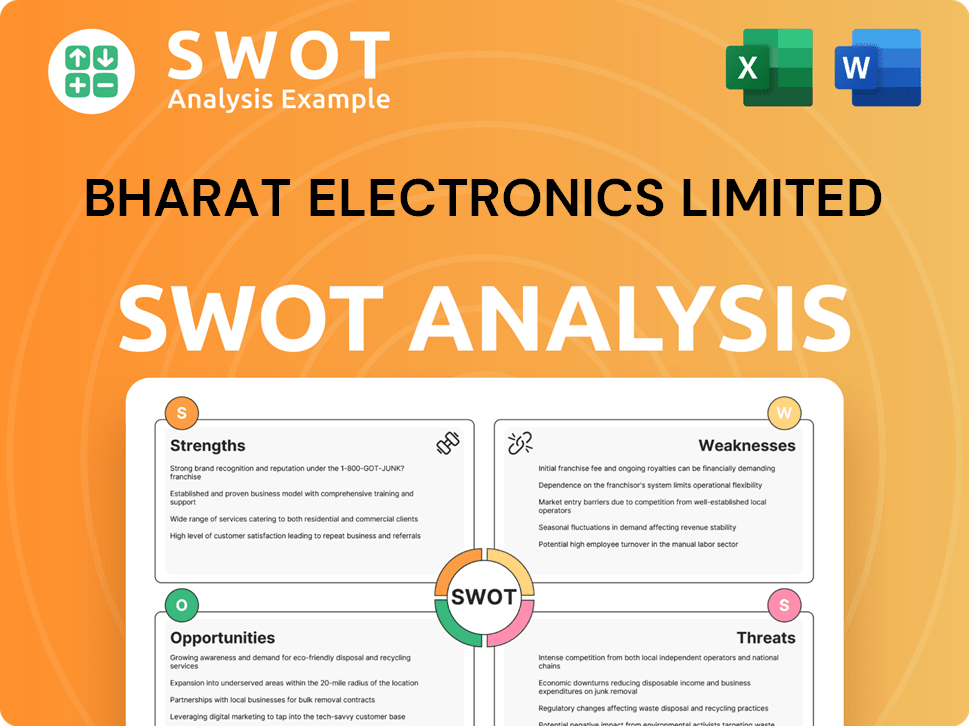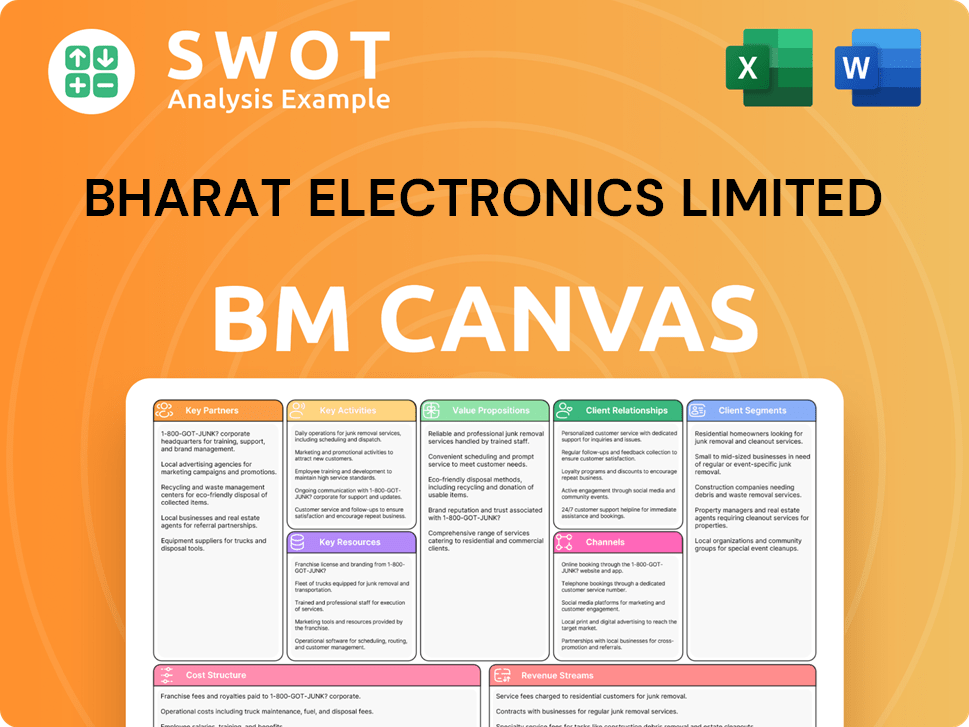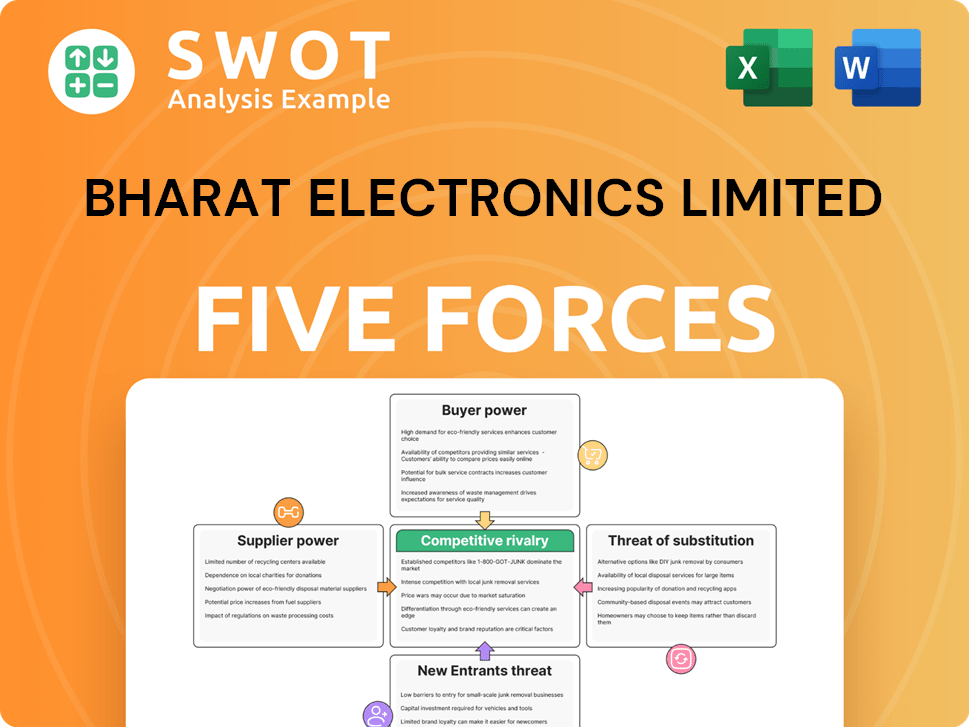Bharat Electronics Limited Bundle
Who Really Owns Bharat Electronics Limited?
Unraveling the ownership structure of a company is key to understanding its strategic direction and potential for growth. For investors and strategists alike, knowing who controls a major player in the Indian defense industry, such as Bharat Electronics Limited (BEL), is crucial. This exploration dives deep into the Bharat Electronics Limited SWOT Analysis, examining its unique position as a Public Sector Undertaking (PSU).

The BEL company, a cornerstone of India's defense capabilities, presents a fascinating case study in state ownership and market dynamics. Understanding the BEL ownership structure, including the role of the Government of India and other key stakeholders, offers invaluable insights. This analysis will illuminate how these ownership dynamics influence BEL's operational decisions, strategic planning, and overall financial performance within the competitive landscape of the Indian defense industry.
Who Founded Bharat Electronics Limited?
Bharat Electronics Limited (BEL), established in 1954, originated as a state-owned enterprise. The foundational structure of the BEL company was designed to ensure direct governmental control. This setup aligned the company's objectives with national defense priorities from the very beginning.
The BEL ownership structure initially involved no individual founders in the traditional sense. The Government of India provided all the initial capital, reflecting the national goal of self-reliance in defense electronics. This approach ensured the company's direction remained firmly aligned with the broader goals of national security and technological self-sufficiency.
As a Public sector undertaking, BEL's early agreements, such as vesting schedules or founder exits, were not applicable. The initial ownership was 100% held by the President of India, acting through the Ministry of Defence. The primary focus was on indigenous development and manufacturing for defense and strategic applications.
The initial ownership of Bharat Electronics Limited was entirely vested in the Government of India. This structure was designed to support the Indian defense industry. The company's creation aimed to foster self-reliance in defense electronics.
- The Government of India provided all initial capital.
- The President of India, through the Ministry of Defence, held 100% ownership.
- No individual founders or private investors were involved in the initial phase.
- The focus was on indigenous development and manufacturing for defense and strategic applications.
Bharat Electronics Limited SWOT Analysis
- Complete SWOT Breakdown
- Fully Customizable
- Editable in Excel & Word
- Professional Formatting
- Investor-Ready Format

How Has Bharat Electronics Limited’s Ownership Changed Over Time?
Bharat Electronics Limited (BEL), a prominent entity in the Indian defense industry, began as a Public Sector Undertaking (PSU) under the Government of India. The journey of BEL ownership has seen a shift from complete government control to a model involving public and institutional investors. This evolution reflects the Indian government's strategy to balance strategic control with market participation, enabling BEL to access capital markets for expansion while maintaining its core defense-related objectives. The Competitors Landscape of Bharat Electronics Limited provides further context on its market position.
The primary change in BEL's ownership structure has been the gradual divestment of shares by the Government of India. This process has allowed for a broader investor base, including institutional investors, mutual funds, and individual shareholders. For instance, the Government of India's stake has decreased over time, with the most recent data from March 2024 showing the government holding 51.11% of the shares. This strategic move has allowed BEL to leverage market dynamics while ensuring the government retains a controlling interest.
| Shareholder Type | Shareholding Percentage (as of March 31, 2024) | Notes |
|---|---|---|
| President of India (through Ministry of Defence) | 51.11% | Largest single shareholder, ensuring government control |
| Foreign Institutional Investors (FIIs) | 18.77% | Significant participation from global investors |
| Domestic Institutional Investors (DIIs) | 18.23% | Includes mutual funds and other domestic entities |
| Public Shareholders | Remaining Percentage | Individual investors |
The major stakeholders in BEL are primarily the Government of India, which remains the largest shareholder, followed by institutional investors, including mutual funds and foreign institutional investors. The shareholding pattern as of March 2024 highlights the significant role of the government, holding 51.11% of the total equity. FIIs hold 18.77%, while DIIs hold 18.23%. This structure allows BEL to operate with a degree of autonomy, while still aligning with the strategic goals of the Indian government. The presence of institutional investors reflects confidence in BEL's performance and its importance in the Indian defense sector.
The Government of India, through the Ministry of Defence, is the primary owner of BEL company. Other major stakeholders include institutional investors, mutual funds, and individual public shareholders.
- The Government of India maintains majority control.
- Institutional investors hold a significant portion of shares.
- Public shareholders also participate in BEL's ownership.
- The shareholding structure reflects a blend of government control and market participation.
Bharat Electronics Limited PESTLE Analysis
- Covers All 6 PESTLE Categories
- No Research Needed – Save Hours of Work
- Built by Experts, Trusted by Consultants
- Instant Download, Ready to Use
- 100% Editable, Fully Customizable

Who Sits on Bharat Electronics Limited’s Board?
The Board of Directors of Bharat Electronics Limited (BEL), a key player in the Indian defense industry, is instrumental in the company's governance. The board typically includes a mix of executive directors, functional directors, and independent directors. As of early 2025, the composition likely features a Chairman and Managing Director, functional directors overseeing areas like finance, research and development, and production. Independent directors are also present, bringing external expertise and ensuring good governance practices, representing the interests of all shareholders.
The Government of India, as the majority shareholder of BEL, significantly influences the board's decisions. The board's structure is designed to ensure effective management and strategic direction, aligning with the company's role as a public sector undertaking. The presence of independent directors provides a layer of oversight, but the government's majority stake ensures its influence on key decisions, including board appointments and strategic initiatives. For more insights into the company's growth strategy, consider reading the growth strategy of Bharat Electronics Limited.
| Director Category | Description | Role |
|---|---|---|
| Chairman and Managing Director | Executive Director | Oversees overall company operations and strategic direction. |
| Functional Directors | Executive Directors | Responsible for specific areas like Finance, R&D, and Production. |
| Independent Directors | Non-Executive Directors | Provide external expertise and oversight, representing shareholder interests. |
The Government of India's significant voting power, stemming from its majority shareholding (51.11% as of March 2024), directly translates to control over key decisions. The voting structure follows a one-share-one-vote principle. This structure means that the government's majority ownership heavily influences strategic direction and policy decisions. The dominance of government shareholding minimizes the likelihood of proxy battles or activist investor campaigns, which are not typical in state-owned enterprises like BEL.
The Government of India, through its majority stake, effectively controls Bharat Electronics Limited (BEL). This control ensures that the company aligns with national strategic objectives, particularly within the Indian defense industry. The board's composition and decision-making processes are significantly influenced by the government's ownership.
- Government of India holds a majority stake.
- Voting power is directly proportional to shareholding.
- Independent directors provide oversight.
- Strategic direction is heavily influenced by the government.
Bharat Electronics Limited Business Model Canvas
- Complete 9-Block Business Model Canvas
- Effortlessly Communicate Your Business Strategy
- Investor-Ready BMC Format
- 100% Editable and Customizable
- Clear and Structured Layout

What Recent Changes Have Shaped Bharat Electronics Limited’s Ownership Landscape?
Over the past few years (2022-2025), the ownership of Bharat Electronics Limited (BEL) has largely remained consistent, with the Government of India maintaining its majority stake. As of March 2024, the Government of India held 51.11% of the shares. This indicates a stable controlling position, although there have been slight adjustments due to strategic disinvestments. These adjustments are part of the government's strategy to generate revenue and encourage wider market participation.
The ownership structure of BEL has seen a gradual increase in institutional ownership. Foreign Institutional Investors (FIIs) held 18.77% and Domestic Institutional Investors (DIIs) held 18.23% as of March 2024. This reflects growing confidence in BEL's financial performance and its role in the Indian defense ecosystem. The government's approach focuses on maintaining strategic control while increasing market liquidity and investor interest. For more details, you can explore the Brief History of Bharat Electronics Limited.
The trends in BEL ownership highlight its status as a Public Sector Undertaking (PSU). The government's strategy involves gradual disinvestment to promote broader market participation while retaining control. This approach aims to balance strategic interests with financial goals, ensuring the company's growth and market competitiveness within the Indian defense industry.
Government of India: 51.11%
Foreign Institutional Investors (FIIs): 18.77%
Domestic Institutional Investors (DIIs): 18.23%
Gradual disinvestment by the Government of India.
Focus on market liquidity and investor interest.
Bharat Electronics Limited Porter's Five Forces Analysis
- Covers All 5 Competitive Forces in Detail
- Structured for Consultants, Students, and Founders
- 100% Editable in Microsoft Word & Excel
- Instant Digital Download – Use Immediately
- Compatible with Mac & PC – Fully Unlocked

Related Blogs
- What are Mission Vision & Core Values of Bharat Electronics Limited Company?
- What is Competitive Landscape of Bharat Electronics Limited Company?
- What is Growth Strategy and Future Prospects of Bharat Electronics Limited Company?
- How Does Bharat Electronics Limited Company Work?
- What is Sales and Marketing Strategy of Bharat Electronics Limited Company?
- What is Brief History of Bharat Electronics Limited Company?
- What is Customer Demographics and Target Market of Bharat Electronics Limited Company?
Disclaimer
All information, articles, and product details provided on this website are for general informational and educational purposes only. We do not claim any ownership over, nor do we intend to infringe upon, any trademarks, copyrights, logos, brand names, or other intellectual property mentioned or depicted on this site. Such intellectual property remains the property of its respective owners, and any references here are made solely for identification or informational purposes, without implying any affiliation, endorsement, or partnership.
We make no representations or warranties, express or implied, regarding the accuracy, completeness, or suitability of any content or products presented. Nothing on this website should be construed as legal, tax, investment, financial, medical, or other professional advice. In addition, no part of this site—including articles or product references—constitutes a solicitation, recommendation, endorsement, advertisement, or offer to buy or sell any securities, franchises, or other financial instruments, particularly in jurisdictions where such activity would be unlawful.
All content is of a general nature and may not address the specific circumstances of any individual or entity. It is not a substitute for professional advice or services. Any actions you take based on the information provided here are strictly at your own risk. You accept full responsibility for any decisions or outcomes arising from your use of this website and agree to release us from any liability in connection with your use of, or reliance upon, the content or products found herein.